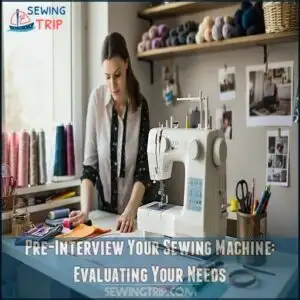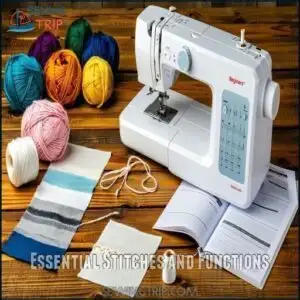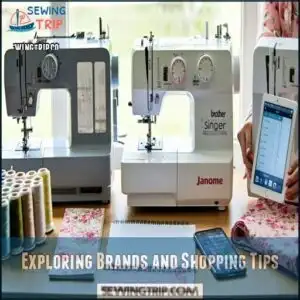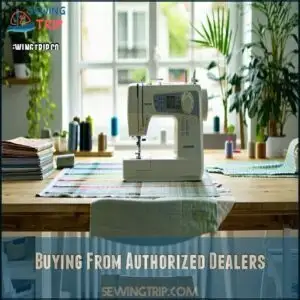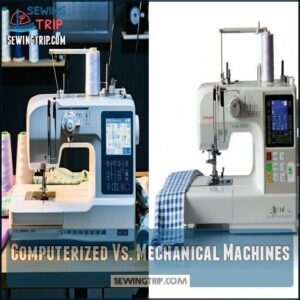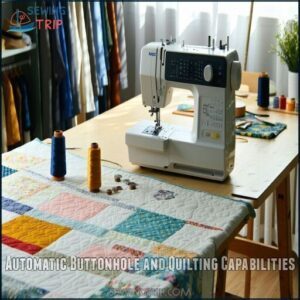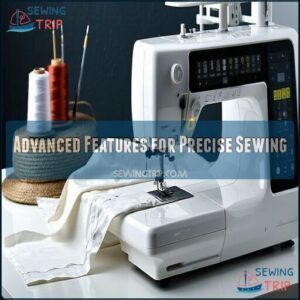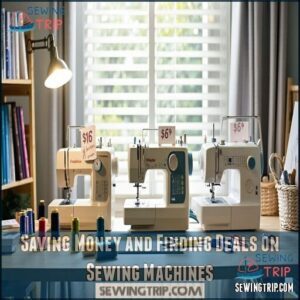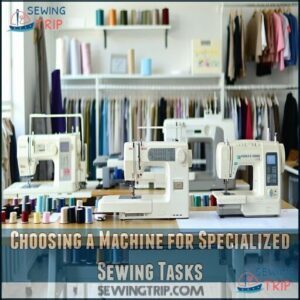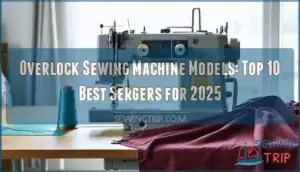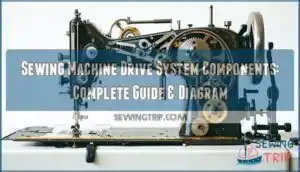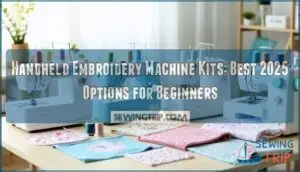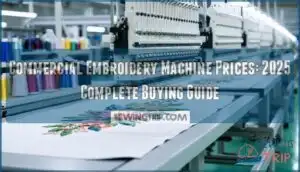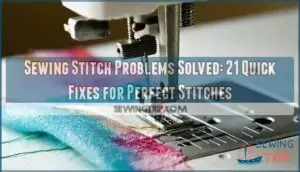This site is supported by our readers. We may earn a commission, at no cost to you, if you purchase through links.
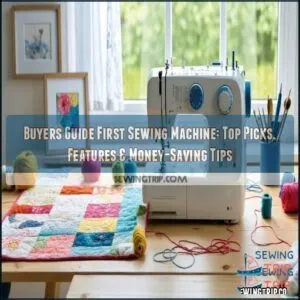 When you’re hunting for your first sewing machine, don’t get tangled in technical jargon.
When you’re hunting for your first sewing machine, don’t get tangled in technical jargon.
Focus on your sewing goals – are you mending clothes, crafting quilts, or starting a creative journey? Look for user-friendly machines with basic stitch options and straightforward controls.
Brands like Brother and Singer offer beginner-friendly models that won’t break the bank. Check for essential features: adjustable stitch length, multiple presser feet, and a simple threading system.
Budget around $100-$300 for a solid starter machine. Remember, your first machine should feel like a trusty sidekick, not a complicated puzzle.
Pro tip: test-drive machines at local craft stores before buying.
Table Of Contents
- Key Takeaways
- Pre-Interview Your Sewing Machine: Evaluating Your Needs
- Choosing The Right Machine: Key Features and Considerations
- Understanding Machine Types and Features
- The Top 4 Sewing Machines for Beginners
- Saving Money and Finding Deals on Sewing Machines
- Choosing a Machine for Specialized Sewing Tasks
- Frequently Asked Questions (FAQs)
- Conclusion
Key Takeaways
- Focus on your sewing goals and choose a machine that matches your needs, like basic stitches for beginners or heavy-duty options for advanced projects.
- Test-drive machines in-store to see if they’re user-friendly and handle the fabrics you’ll work with.
- Stick to reliable beginner models from brands like Brother, Singer, or Janome that cost between $100-$300.
- Look for must-have features like an automatic needle threader, adjustable speed, and a durable build.
Pre-Interview Your Sewing Machine: Evaluating Your Needs
Before choosing your first sewing machine, take a moment to evaluate what you actually need.
Think about your sewing habits, frequency, and the types of projects you want to tackle to confirm the machine aligns with your goals.
Assessing Current Machine and Sewing Habits
Thinking about your first sewing machine? Start by evaluating your current setup—or if you’re starting fresh, consider your expectations. Is sewing easy, or an uphill battle with skipped stitches and fabric jams? Be honest about your Sewing Frequency and User Habits.
Think through these questions:
- Does your machine fit your sewing space or take up too much room?
- Can it handle various Project Types, like lightweight fabrics or denim?
- Are the Machine Capabilities meeting your Sewing Goals, or are you frustrated with limited stitch options?
Before committing, learn what works for your sewing style—it’ll make all the difference!
Determining Sewing Frequency and Project Types
How often you sew shapes your machine choice.
Occasional sewing? A beginner sewing machine fits your needs. For frequent projects or heavier tasks, consider mid-range or heavy-duty options.
Match your machine to your sewing habits, planned sewing projects, and fabric types.
Hemming jeans? Quilting? Durable machines handle thick materials better.
| Sewing Style | Best Machine Type | Common Projects |
|---|---|---|
| Weekend Hobbyist | Beginner Model | Simple crafts, mending |
| Regular Sewer | Reliable Mid-Range | Quilts, denim hemming |
| Daily Maker | Heavy-Duty Machine | Upholstery, multiple layers |
Matching Machine Capabilities to Your Sewing Goals
Every project starts with knowing your sewing needs.
For light fabrics, go with a beginner sewing machine that offers essential stitch options.
Tackling denim or quilts? Look for machine types with adjustable speed and specialized fabric handling.
A great sewing machine buying guide helps balance budget planning with features you need.
Matching machine capabilities to your goals guarantees your sewing machine becomes your ideal creative partner.
Choosing The Right Machine: Key Features and Considerations
Choosing the right sewing machine means focusing on the features you’ll use most often and planning for future projects.
From essential stitches to advanced options, understanding your needs helps you select a machine that’s practical, reliable, and easy to use, with features that support your growth, making it a reliable tool for your sewing endeavors.
Essential Stitches and Functions
When picking a beginner sewing machine, focus on essential stitches that cover most projects.
These include the Straight Stitch for seams, the Zigzag Stitch for stretch fabrics, and the Buttonhole for fastenings.
Add the Overlock Stitch for neat edges and a Hemming Function to tackle finishing tasks.
Look for user-friendly sewing machine features that simplify projects:
- Automatic needle threader—because threading shouldn’t be a battle.
- Adjustable tension settings to keep stitches smooth.
- Clear stitch variety to fuel creativity.
- Good fabric feed for frustration-free sewing.
- Simple guides for learning on the go.
Understanding sewing machine basics is vital for selecting the right machine.
With the right basic stitches and automatic features, you’ll stitch confidently, even as a beginner sewist.
Exploring Brands and Shopping Tips
Finding your first sewing machine is easier when you focus on trusted sewing machine brands known for their reliability. Start with brand research—Brother, Singer, and Janome are favorites among beginners for their user-friendly designs and dependable performance.
Make sure to visit local shops with fabric scraps in hand; testing machines will give you a feel for their ease of use. Don’t hesitate to ask staff for guidance—they’re usually happy to help.
Before buying, do a price comparison and check online shop reviews. Always look at warranty options for added peace of mind.
Here’s your quick buying guide checklist:
- Stick to beginner sewing machines from reliable brands.
- Compare sewing machine prices online and in-store.
- Look for customer reviews and dealer support.
- Choose quality over unnecessary bells and whistles.
- Test machines beforehand—it’s worth the effort.
When selecting a machine, consider the importance of home sewing machine choices to make certain you find the right fit for your needs.
Buying From Authorized Dealers
Buying your first sewing machine? Stick with authorized dealers for a hassle-free start.
**Why choose authorized retailers?
First, they guarantee genuine products—no surprises with faulty knock-offs. Plus, with a sewing machine warranty, you’re covered if something breaks. Most authorized dealers also offer a sewing machine service plan** to keep it running like new.
Local sewing machine dealerships provide a high-quality purchase experience. You can test-drive machines in-store or through virtual demos, making sure you find the perfect fit. Staff are knowledgeable and offer sales support, answering questions so you won’t feel overwhelmed.
Down the road, their repair services and easy-to-navigate return policies come in handy. That shady “too-good-to-be-true” deal online? Skip it. You’ll avoid unnecessary headaches by working with trusted sewing machine dealerships.
An authorized dealer saves time, money, and guarantees your sewing journey is off to a smooth start!
Understanding Machine Types and Features
Choosing between a computerized and mechanical sewing machine comes down to your sewing goals and comfort with technology.
Understanding key features like automatic buttonholes, quilting capabilities, and advanced precision tools helps you match the machine to your needs.
Computerized Vs. Mechanical Machines
Machines tell different stories—mechanical models whisper classic reliability, while computerized ones sing modern sewing convenience.
Choosing between a computerized machine and a mechanical machine is like deciding between a high-tech gadget and an old-school reliable tool. Both excel, depending on your sewing goals.
High-tech or classic: choose a sewing machine that matches your creative spirit and skill level.
A mechanical sewing machine is straightforward, making it perfect for beginners. You control settings with knobs, ensuring a tactile experience. Meanwhile, a computerized machine brings automatic features and modern sewing convenience but can feel overwhelming if you’re just starting.
Here’s the breakdown:
- Sewing Speed: Computerized models are faster, but mechanical ones offer steady control.
- Thread Control: Mechanical machines keep it simple, while computerized ones adjust automatically.
- Bobbin Management: Computerized models alert you when it’s low.
- Motor Efficiency: Mechanical machines are built for durability.
- Stitch Options: Computerized machines shine with creative possibilities.
Choose based on your needs and comfort!
Automatic Buttonhole and Quilting Capabilities
A sewing machine that offers automatic buttonhole settings simplifies closures, making tricky tasks effortless. It’s a game-changer, especially for beginners!
If quilting excites you, explore machines with quilting modes, like a drop feed dog, for smooth free-motion creativity. Combine this with excellent fabric control and thread management to tackle your dream projects.
When selecting a machine, consider the benefits of an Automatic Sewing system for enhanced productivity.
Here’s a quick comparison:
| Feature | Benefits | Ideal For | Common in |
|---|---|---|---|
| Automatic Buttonhole | Simplifies closures | Beginners, garment makers | Most models |
| Quilting Modes | Enhanced free-motion sewing | Quilters, hobbyists | Mid/high-range models |
| Stitch Options | Project versatility | Home sewists | Entry-level + |
| Thread Management | Smoother stitching | All users | Advanced machines |
Keep these features in mind to enjoy sewing precision and versatility!
Advanced Features for Precise Sewing
Picture sewing with precision akin to painting delicate strokes—control is your best friend! Computerized sewing machines pack advanced features to make each stitch perfect. Tools like an automatic threader or automatic thread cutter save time while boosting accuracy.
Here’s what to look for:
- Needle Control: Adjust positions for tight corners or creative topstitching.
- Fabric Feed System: Guarantees smooth, even stitches on tricky fabrics.
- Sewing Speed Settings: Offers control for beginners or detailed projects.
- Free Motion Capabilities: Perfect for quilting and custom designs, enabling bold creative freedom.
The Top 4 Sewing Machines for Beginners
Choosing your first sewing machine can feel overwhelming, but starting with the right model makes all the difference.
Here are four beginner-friendly sewing machines that offer essential features, ease of use, and great value for the price, which can help make a significant difference in your sewing experience with the right sewing machine.
1. Brother CS7000i Sewing Quilting Machine
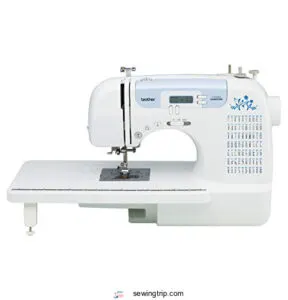
Looking for a sewing machine with versatility, ease of use, and reliable performance? The Brother CS7000i is a standout choice for beginners and intermediate users alike.
Packed with 70 built-in stitch options—including quilting, utility, and decorative stitches—it’s designed to handle everything from altering garments to piecing quilts.
This beginner-friendly sewing machine features an automatic needle threader (no more squinting to thread!) and a drop-in top bobbin system that prevents jams, keeping your sewing frustration-free.
Quilting enthusiasts will appreciate the wide table and quilting modes, perfect for managing larger projects.
It stitches at a solid 750 stitches per minute, with adjustable speed for precision and comfort.
- Reliable build that handles heavy fabrics.
- Adjustable sewing speed for control.
- A compact, lightweight design perfect for all skill levels!
2. Brother GX37 Sewing Machine
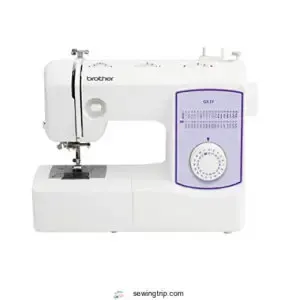
The Brother GX37 is a fantastic beginner sewing machine, offering just the right balance of simplicity and versatility.
If you’re starting your sewing journey, its 37 built-in stitch options—from basic to decorative—let you tackle various projects, whether that’s hemming pants or crafting intricate designs.
Say goodbye to threading headaches! The automatic needle threader and drop-in bobbin system make setup smooth, letting you sew without constant interruptions.
Its adjustable sewing speed gives you total control, whether you’re working on delicate fabrics or thick layers.
Built with six sewing feet, including options for zigzag and buttonholes, this beginner sewing machine feels like having a pro toolkit.
It’s lightweight yet durable, ideal for small homes or workspaces.
Here’s a quick breakdown:
Affordable and user-friendly, the Brother GX37 helps you kickstart sewing confidently.
3. Singer Heavy Duty Sewing Machine
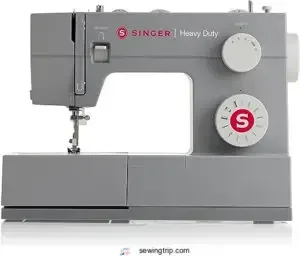
The Singer Heavy Duty 4423 is a powerhouse that’s perfect for turning sewing dreams into reality.
Designed with a sturdy metal frame, it’s built for everything—delicate silks, thick denim, or layered fabrics.
Its standout Singer Features include impressive sewing speed at 1,100 stitches per minute, letting you race through projects without losing stitch quality.
This beginner sewing machine offers 69 stitch applications, from a versatile straight stitch to a flawless one-step buttonhole, covering most creative needs.
Paired with a top drop-in bobbin and adjustable presser foot pressure, using this machine feels effortless, even for a first-timer.
Here’s why the Singer Heavy Duty stands out:
- Built to Last: Strong frame guarantees vibration-free performance.
- High Sewing Speed: Fast completion of large projects.
- Versatile Stitch Options: For garments, heavy-duty work, and more.
- Exceptional Durability: Backed by a 25-year warranty.
The machine’s heavy duty features make it suitable for a wide range of sewing tasks.
It’s a reliable investment for beginners looking for durability and power!
4. Janome Pink Sorbet Sewing Machine
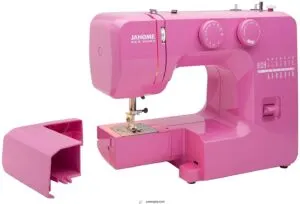
Starting your sewing journey? The Janome Pink Sorbet is a beginner sewing machine you’ll love. With 15 built-in stitches and a sturdy metal frame, it’s designed to handle your first sewing projects with ease and precision.
Stitch variety is simple to control using its adjustable settings, offering flexibility for various tasks. The free arm is a lifesaver for sewing cuffs, sleeves, and other small areas.
Although its bobbin management might take some getting used to, its 25-year warranty adds peace of mind. Plus, tutorial videos walk you through features step-by-step, making it one of the best sewing machines for beginners.
Stylish, reliable, and durable, this sewing machine also offers smooth sewing speed and dependable thread control. It’s a dependable first sewing machine to spark your new hobby!
Saving Money and Finding Deals on Sewing Machines
You can save money on your first sewing machine by exploring trade-in options and negotiating with dealers for better prices.
Keep an eye on online sales, coupons, and seasonal events to snag quality machines at a discount.
Negotiating With Dealers and Leveraging Trade-ins
Negotiating with dealers can feel intimidating, but it’s worth it for the deals. Start by asking, “What’s your best price?” with confidence and a smile.
Mention competitor pricing to encourage price matching. If you’ve got an old machine, trade-ins can score you $50-$200 depending on the brand and condition.
Don’t stop there—ask about warranty deals, free beginner classes, or extras like maintenance kits and bobbins. Sales tactics like these appeal to dealers looking to build long-term relationships.
They want your repeat business, so don’t hesitate to push for added value. Dealer negotiation is your best tool for snagging perks and saving on your first machine.
Online Sales, Coupons, and Sales Events
Finding deals online is like a treasure hunt—fun and rewarding when you know where to look.
After chatting with dealers, take your savings hunt to the web! Use these smart moves:
- Sign up for sales alerts on sites like SewingMachinesPlus or Joann to track discounts and coupons.
- Bookmark key sales events like Black Friday or Memorial Day, when online deals hit their best price points.
- Join sewing groups or forums for insider coupon strategies—members often share flash codes or promotions.
- Use browser tools like Honey to apply discount codes automatically at checkout.
A little patience and strategy can score you impressive savings without stepping into a store!
Investing in Quality Over Quantity
A smart sewing machine isn’t just a purchase—it’s an investment in your creative potential.
Chasing discounts is smart, but don’t sacrifice longterm value for short-term savings.
A reliable sewing machine with quality features guarantees durability and sewing efficiency, saving you headaches later. Think of it as smart budget planning—investing in a beginner sewing machine that performs well and grows with you beats nursing a fragile, frustrating one.
Invest in a sewing machine that grows with you, not one that holds you back.
Trusted brands deliver machines that handle everything from delicate fabrics to thicker materials like denim. A sturdy, well-built option also holds its resale value and reduces repair hassles.
When considering sewing machine features, focus on performance and durability over flashy extras. Finding the best sewing machine deals can help you make an informed decision and stay within your budget.
Choosing a Machine for Specialized Sewing Tasks
If you’re planning to tackle specialized sewing projects like quilting, dressmaking, or upholstery, you’ll need a machine that’s up to the challenge.
Your ideal sewing machine should match your specific needs, offering features that make your creative vision a reality while providing the versatility to grow with your skills.
Quilting and Dressmaking Features
Looking to transform your sewing game? A quilting and dressmaking machine isn’t just a tool—it’s your creative companion.
Choose wisely with these must-have features:
- Wide throat space for wrestling bulky quilts into submission
- Adjustable presser foot pressure that adapts to delicate fabrics like a chameleon
- Automatic needle threader that saves your eyesight and sanity
- Free-motion quilting capability releasing your inner design wizard
Your computerized sewing machine should be a precision instrument. Nail those automatic buttonholes on dresses and position your needle with laser-like accuracy.
A walking foot becomes your secret weapon, guiding fabric layers smoothly through each project. With the right machine, you’ll stitch dreams into reality, turning complex designs into stunning masterpieces that’ll make other sewists green with envy.
Mastering sewing machine quilting techniques can elevate your sewing skills to the next level.
Upholstery and Heavy-Duty Requirements
When diving into upholstery projects, you’ll want a sewing machine that’s built like a tank.
Industrial sewing machines reign supreme for heavy fabric challenges, offering robust motors and walking foot mechanisms that slice through thick seams like butter.
Prioritize machines with metal components and adjustable presser foot pressure—these features are your secret weapons for conquering denim, leather, and multi-layered upholstery projects.
Brands like Juki, Pfaff, and Consew specialize in heavy-duty models designed to handle intense sewing demands.
While industrial machines pack a serious punch, some high-end domestic models can tackle tough jobs too.
Don’t skimp on thread quality; opt for heavy-duty nylon threads that’ll stand up to wear and tear.
Considerations for Beginner Sewers
After wrestling with heavy-duty fabric challenges, beginners need a gentler machine companion. Your first sewing machine should feel like a trusty sidekick, not an intimidating robot.
- Seek simple threading paths that won’t test your patience
- Opt for intuitive stitch selection without constant manual-flipping
- Prioritize an automatic needle threader that saves your eyesight
When selecting your beginner sewing machine, match it to your budget and anticipated projects. Start with basic features that won’t overwhelm you, leaving room to grow your skills without breaking the bank. Understanding sewing machine basics is essential for making an informed decision. Your sewing journey starts here.
Frequently Asked Questions (FAQs)
What to look for when buying your first sewing machine?
Ready to thread your way to sewing success?
Don’t get tangled up! Prioritize essential stitches, test-drive machines with your fabric, focus on durability.
Choose a model that’ll grow with your skills without breaking the bank, and test-drive machines with your fabric to ensure compatibility and performance.
What sewing machine to buy for a beginner?
You’ll want a sturdy mechanical machine between $200-$400 from brands like Brother or Janome.
Pick one with basic stitches, buttonhole function, and an adjustable speed dial that’ll grow with your sewing skills and passion.
How to pick the first sewing machine?
Choose a machine that matches your budget and skills.
Test drive at local shops, focusing on essential stitches and ease of use.
Consider future projects, but don’t overspend on fancy features you’ll rarely use.
How much should I spend on my first sewing machine?
Surprisingly, 72% of beginners overspend on their first machine.
You’ll want to invest $200-$400 for a reliable, feature-packed sewing machine that’ll grow with your skills without breaking the bank or overwhelming you.
What sewing machine is good for a beginner?
For beginners, grab a straightforward mechanical machine like the Brother CS6000i.
It’s affordable, user-friendly, and packs essential stitches without overwhelming you.
Look for models between $200-$400 that’ll grow with your sewing skills.
What should I buy as a beginner sewing?
You’ll rock a starter machine between $200-$400 with basic stitches from Singer or Brother.
Look for straight and zigzag options, an automatic needle threader, and a few presser feet to kickstart your sewing adventure.
What are the guidelines for choosing a sewing machine?
When hunting for your first sewing machine, focus on essential features like basic stitches, ease of use, and budget.
Test different models, prioritize durability, and match the machine to your sewing goals and skill level.
How to buy the best sewing machine?
Want to dodge sewing machine shopping paralysis?
Don’t get tangled in features, focus on your projects, budget, and skill level.
Test-drive machines, prioritize essential stitches, and invest wisely in a machine that’ll grow with your creativity.
What should I consider before buying a sewing machine?
Consider your sewing goals, budget, and fabric types before buying. Test machines hands-on, prioritize essential features, and choose a model that’ll grow with your skills without breaking the bank.
Is buying a sewing machine a good investment?
Picture yourself transforming fabric into art—a sewing machine isn’t just a tool, it’s your creative passport.
If you’ll sew regularly, invest wisely; choose a machine matching your skills and dreams for endless crafting potential.
Conclusion
Shopping for your first sewing machine can feel like discovering a world of endless creativity.
Remember to match your needs with features that matter—simple threading, a variety of stitches, and good durability.
Stick with trusted brands like Brother, Singer, or Janome, balancing quality and cost.
Test machines where possible and explore deals online.
With this buyers guide for your first sewing machine, you’ll confidently start sewing projects without getting overwhelmed, and sew your dreams!

